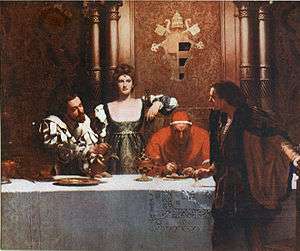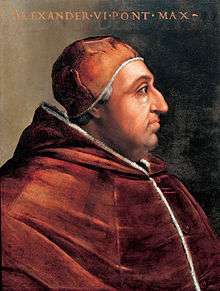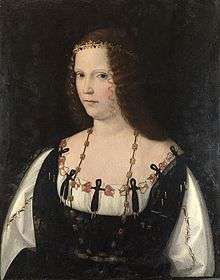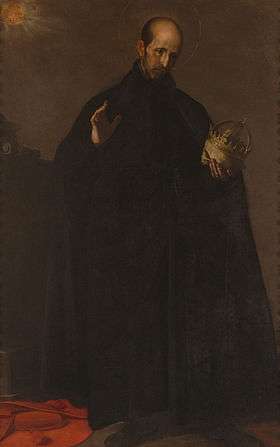House of Borgia
| Borgia Borja | |
|---|---|
| Noble house | |
|
| |
| Country | Spain, Italy, France |
| Titles |
|
| Founded | 1455 |
| Founder | Alfons de Borja |
| Final ruler | Pope Alexander VI |
| Current head | Rodrigo Borja Cevallos |
| Deposition | 1672 |
| Ethnicity | Spanish |

.svg.png)
The House of Borgia (/ˈbɔːrʒə/; Italian: [ˈbɔrdʒa]; Spanish: Borja [ˈborxa]; Valencian: Borja [ˈbɔɾdʒa]) was an Italo-Spanish noble family, which rose to prominence during the Italian Renaissance. They were from Valencia, the surname being a toponymic from Borja, then in the Crown of Aragon, in Spain.
The Borgias became prominent in ecclesiastical and political affairs in the 15th and 16th centuries, producing two popes: Alfons de Borja, who ruled as Pope Callixtus III during 1455–1458, and Rodrigo Lanzol Borgia, as Pope Alexander VI, during 1492–1503.
Especially during the reign of Alexander VI, they were suspected of many crimes, including adultery, incest, simony, theft, bribery, and murder (especially murder by arsenic poisoning).[1] Because of their grasping for power, they made enemies of the Medici, the Sforza, and the Dominican friar Savonarola, among others. They were also patrons of the arts who contributed to the Renaissance.
History
Early history
The Borja or Borgia emerged from Valencia in the Crown of Aragon, Spain. There were numerous unsubstantiated claims that the family was of Jewish origin. These underground rumours were propagated by, among others, Giuliano della Rovere, and the family was frequently described as marranos by political opponents. The rumours have persisted in popular culture for centuries, listed in the Semi-Gotha of 1912.[2][3][4]
Alfons
Alfons de Borja, later known as Pope Callixtus III (1378–1458), was born to Francina Llançol and Domingo de Borja in La Torreta, Canals, which was then situated in the Kingdom of Valencia.
Alfons de Borja was a professor of law at the University of Lleida, then a diplomat for the Kings of Aragon before becoming a cardinal. At an advanced age, he was elected Pope Callixtus III in 1455 as a compromise candidate and reigned as Pope for just 3 years.
Rodrigo
Rodrigo Borgia (1431–1503), one of Alfonso’s nephews, was born in Xàtiva, also in the Kingdom of Valencia, to Isabel de Borja i Cavanilles and Jofré Llançol i Escrivà. He studied law at Bologna and was appointed as cardinal by his uncle, Alfonso Borgia, Pope Callixtus III. He was elected Pope in 1492, taking the regnal name Alexander VI. While a cardinal, he maintained a long-term illicit relationship with Vannozza dei Cattanei, with whom he had four children: Giovanni; Cesare; Lucrezia; and Gioffre. Rodrigo also had children by other women, including one daughter with his mistress, Giulia Farnese.
As Alexander VI, Rodrigo was recognized as a skilled politician and diplomat, but was widely criticized during his reign for his over-spending, sale of Church offices (simony), lasciviousness, and nepotism. As Pope, he struggled to acquire more personal and papal power and wealth, often ennobling and enriching the Borgia family directly. He appointed his son, Giovanni, as captain-general of the papal army, his foremost military representative, and established another son, Cesare, as a cardinal. Alexander used the marriages of his children to build alliances with powerful families in Italy and Spain. At the time, the Sforza family, which comprised the Milanese faction, was one of the most powerful in Europe, so Alexander united the two families by marrying Lucrezia to Giovanni Sforza. He also married Gioffre, his youngest son from Vannozza, to Sancha of Aragon of the Crown of Aragon and Naples. He established a second familial link to the Spanish royal house through Giovanni's marriage during what was a period of on-again/off-again conflict between France and Spain over the Kingdom of Naples.
It is reported that under Alexander VI's rule the Borgias hosted orgies in the Vatican palace. The "Banquet of Chestnuts" is considered one of the most disreputable balls of this kind. Johann Burchard reports that fifty courtesans were in attendance for the entertainment of the banquet guests.[5] It is alleged not only was the Pope present, but also two of his children, Lucrezia and Cesare. Other researchers however, such as Monsignor Peter de Roo (1839–1926), have rejected the rumors of the "fifty courtesans" as being at odds with Alexander VI's essentially decent but much maligned character.[6]
Pope Alexander VI died in Rome in 1503 after contracting a disease, generally believed to have been malaria. Two of Alexander's successors, Sixtus V and Urban VIII, described him as one of the most outstanding popes since St. Peter.[7]
Cesare

Cesare was Rodrigo Borgia's second son with Vannozza dei Cattanei. Cesare's education was precisely planned by his father: he was educated by tutors in Rome until his 12th birthday. He grew up to become a charming man skilled at war and politics.[8] He studied law and the humanities at the University of Perugia, then went to the University of Pisa to study theology. As soon as he graduated from the university, his father made him a cardinal.
Cesare was suspected of murdering his brother Giovanni, but there is no clear evidence to confirm this. However, Giovanni’s death cleared the path for Cesare to become a layman and gain the honors his brother received from their father, Pope Alexander VI.[9] Although Cesare had been a cardinal, he left the holy orders to gain power and take over the position Giovanni once held: a condottiero. He was finally married to French princess Charlotte d'Albret.
After Alexander’s death in 1503, Cesare affected the choice of a next Pope. He needed a candidate who would not threaten his plans to create his own principality in Central Italy. Cesare’s candidate (Pius III) did become Pope, but he died a month after the selection. Cesare was then forced to support Giuliano della Rovere. The cardinal promised Cesare that he could keep all of his titles and honors. Later, della Rovere betrayed him and became his fiercest enemy.
Cesare died in 1507, at Viana Castle in Navarre, Spain while besieging the rebellious army of Count de Lerín. The castle was held by Louis de Beaumont at the time it was besieged by Cesare Borgia and King John's army of 10,000 men in 1507. In order to attempt to breach the extremely strong, natural fortification of the castle, Cesare counted on a desperate surprise attack. He was killed during the battle, in which his army failed to take the castle.
Lucrezia
Lucrezia was born in Subiaco, Italy to Cardinal Rodrigo Borgia and Roman mistress Vannozza dei Catanei. Before the age of 13, she was engaged to two Spanish princes. After her father became Pope she was married to Giovanni Sforza in 1493 at the age of 13. It was a typical political marriage to improve Alexander's power; however, when Pope Alexander VI no longer needed the Sforzas, the marriage was annulled in 1497 on the dubious grounds that it had never been consummated.
Shortly afterwards she was involved in a scandal involving her alleged relationship with a Pedro Calderon, a Spaniard generally known as Perotto. His body was found in the Tiber on February 14, 1498, along with the body of one of Lucrezia's ladies. It is likely that Cesare had them killed as an affair would have damaged the negotiations being conducted for another marriage. During this time rumors were also spread suggesting that a child born at this time, Giovanni Borgia, also known as the Infans Romanus (child of Rome) was Lucrezia's.[10]
Lucrezia’s second marriage, to wealthy young Prince Alfonso of Aragon, allowed the Borgias to form an alliance with another powerful family. However, this relationship did not last long either. Cesare wished to strengthen his relations with France and completely break with the Kingdom of Naples. As Alfonso's father was the ruler of the Kingdom of Naples, the young husband was in great danger. Although the first attempt at murder did not succeed, Alfonso was eventually strangled in his own quarters.
Lucrezia's third and final husband was Alfonso I d'Este, Duke of Ferrara. After her father died in 1503, she lived a life of freedom in Ferrara with her husband and children.[11] Unfortunately, her pregnancies were difficult and she lost several babies after birth. She died in 1519, 10 days after the birth and death of her last child, Isabella Maria. She was buried in a tomb with Isabella and Alfonso.
Lucrezia was rumored to be a notorious poisoner and she became famous for her skill at political intrigue. However, recently historians have started to look at her in a more positive light: she is often seen as a victim of her family’s deceptions.[12]
Family tree

Other notable Borjas/Borgias
Gioffre Borgia (1482–1516), son of Pope Alexander VI and younger brother of Cesare Borgia and Lucrezia Borgia. He married Sancha of Aragon, daughter of Alfonso II of Naples, obtaining as her dowry both the Principality of Squillace (1494) and the Duchy of Alvito (1497). Although Gioffre lost Alvito after her death in 1506, he managed to retain Squillace. He subsequently married Maria de Mila y Aragón, and passed the title on to their son Francesco Borgia.
Francis Borgia, 4th Duke of Gandía (1510–1572), great-grandson of Pope Alexander VI. He had fathered a number of children and after his wife died, Francisco determined to enter the Society of Jesus, recently formed by Ignatius of Loyola, and became a highly effective organizer of the still-new order. His efforts were effective, as Clement X canonized him "Saint Francis Borgia" on 20 June 1670.[13]
Gaspar de Borja y Velasco (1580–1645) was born at Villalpando in Spain, and unlike many of his relatives, he preferred to use the Spanish spelling "Borja". He was related to both Callixtus III and Alexander VI, and some historians believe that Gaspar wished, like his relatives, to become Pope. He served as Primate of Spain, Archbishop of Seville, and Archbishop and Viceroy of Naples.
Luz Elisa Borja Martínez (1903–1927) was an Ecuadorian poet, pianist, painter, and sculptor.
Portraits of the Borjas/Borgias
 Alfons de Borja
Alfons de Borja
Pope Callixtus III Rodrigo Borgia
Rodrigo Borgia
Pope Alexander VI, father of Cesare, Giovanni, Lucrezia and Gioffre.

 Lucrezia Borgia
Lucrezia Borgia
Duchess of Ferrara and Modena Gioffre Borgia
Gioffre Borgia
Prince of Squillace
 Juan de Borja.
Juan de Borja.
President of the Real Audiencia de Santa Fe de Bogotá
In popular culture
The Borgias were infamous in their time, and have inspired numerous references in popular culture, including novels, plays, operas, comics, films, television series and video games.
- The Prince (1513) by Niccolò Machiavelli
- The Borgias (1802) by Alexandre Dumas, père[14]
- Lucrezia Borgia (1833) by Victor Hugo (play)
- Lucrezia Borgia (1833) by Gaetano Donizetti (opera)
- Borgia! (1906) by Michel Zevaco
- The Banner of the Bull (1915) by Rafael Sabatini
- Don Juan (1926), starring John Barrymore
- Then and Now (1946) by W. Somerset Maugham
- Prince of Foxes (1947) by Samuel Shellabarger
- The Borgia Testament (1948) by Nigel Balchin
- Prince of Foxes (1949), starring Orson Welles
- Bride of Vengeance (1949), starring Paulette Goddard, John Lund, Macdonald Carey
- The Scarlet City (1952) by Hella Haasse
- Madonna of the Seven Hills (1958) by Jean Plaidy
- Light on Lucrezia (1958) by Jean Plaidy
- Contes immoraux, (1974) French film by Walerian Borowczyk
- Francesca (1977) by Valentina Luellen
- City of God: A Novel of the Borgias (1979) by Cecelia Holland[15]
- The Antipope (1981) by Robert Rankin
- The Borgias (1981), BBC Two TV miniseries
- A Matter of Taste (1990) by Fred Saberhagen
- Cantarella (2001–2010) by You Higuri (manga)
- The Family (2001) by Mario Puzo
- Mirror Mirror (2003) by Gregory Maguire
- The Borgia Bride (2005) by Jeanne Kalogridis
- Queen of the Slayers (2005) by Nancy Holder
- Cesare (2005-) by Fuyumi Soryo (manga)
- Predator: Concrete Jungle (2005) by Eurocom
- The Medici Seal (2006) by Theresa Breslin
- Los Borgia (2006), Spanish film by Antonio Hernández
- The Conclave (2006), film by Paul Donovan
- Assassin's Creed: Brotherhood (2010) by Ubisoft[16]
- Borgia (2011), Canal + TV series
- Borgia (2011), comic by Alejandro Jodorowsky and Milo Manara
- The Borgias (2011), Showtime TV series[17]
See also
- Grandee of Spain
- List of popes from the Borgia family
- Borgia castles
- Route of the Borgias
- Monastery of Sant Jeroni de Cotalba
Notes
- ↑ Arsenic: A Murderous History. Dartmouth Toxic Metals Research Program, 2009
- ↑ The Menorah journal, Volumes 20-23, Intercollegiate Menorah Association, 1932, page 163
- ↑ The Borgias: or, At the feet of Venus, Vicente Blasco Ibáñez, P. Dutton & Co. Inc., 1930, pages 242, 313
- ↑ Lucrezia Borgia: Life, Love and Death in Renaissance Italy, by Sarah Bradford
- ↑ Johann Burchard, Pope Alexander VI and His Court: Extracts from the Latin Diary of Johannes Burchardus, 1921, F.L. Glaser, ed., New York, N.L. Brown, pp. 154-155.
- ↑ In 5 volumes totaling nearly 3 thousand pages, and including many unpublished documents,* Msgr. de Roo labors to defend his thesis that pope Alexander, far from being a monster of vice (as he has so often been portrayed) was, on the contrary, "a man of good moral character and an excellent Pope." Material, vol. 1, preface, xi.
* "[Peter de Roo] must have devoted to his task many years of research among the Vatican archives and elsewhere. As he tells us himself in a characteristic passage: "We continued our search after facts and proofs from country to country, and spared neither labour nor money in order to thoroughly investigate who was Alexander VI., of what he had been accused, and especially what he had done." Whether all this toil has been profitably expended is a matter upon which opinions are likely to differ. But we must in any case do Mgr. de Roo the justice of admitting that he has succeeded in compiling from original and often unpublished sources a much more copious record of the pontiff's creditable activities than has ever been presented to the world before." -- Pope Alexander VI and His Latest Biographer, in The Month, April, 1925, Volume 145, p. 289. - ↑ Mallett, M. The Borgias (1969) Granada edition. 1981. p. 9.
- ↑ "Francis Borgia (1510–1572)". The Thames & Hudson Dictionary of the Italian Renaissance. London: Thames & Hudson. 2006.
- ↑ Najemy, John (September 2013). Machiavelli and Cesare Borgia: A Reconsideration of Chapter 7 of The Prince. (Volume 75 Issue 4 ed.). Review of politics. pp. 539–556.
- ↑ Bradford, Sarah (2005). Lucrezia Borgia: Life, Love and Death in Renaissance Italy (Reprint ed.). Penguin. pp. 67–68. ISBN 978-0143035954.
- ↑ "Borgia, Lucrezia (1480–1519)". The Penguin Biographical Dictionary of Women. London: Penguin. 1998.
- ↑ Lucrezia Borgia: A Biography. Rachel Erlanger, 1978
- ↑ "Francis Borgia (1510–1572)". Who's Who in Christianity. London: Routledge. 2001.
- ↑ http://www.fullbooks.com/The-Borgias1.html
- ↑ Maclaine, David. "City of God by Cecelia Holland". Historicalnovels.info. Retrieved September 5, 2014.
- ↑ Snider, Mike. "'Assassin' is back with 'Brotherhood'". USA Today.
- ↑ Donahue, Deirdre (24 March 2011). "Back in time and in crime with Borgias". Life.
References
- Fusero, Clemete. The Borgias. New York, Praeger Publishers, 1966.
- Grun, Bernard. The Timetables of History. New York, Simon and Schusters, 1946, pp. 218, 220, 222.
- Hale, John R. Renaissance. New York, Time-Life Books, 1965, p. 85.
- "Mad Dogs and Spaniards: An Interview with Cesare Borgia." World and Image, 1996.
- Rath, John R. "Borgia." World Book Encyclopedia. 1994 edition. World Book Inc., 1917, pp. 499–500.
- Catholic Encyclopedia, Volume 1. (Old Catholic Encyclopedia) New York, Robert Appleton Company (a.k.a. The Encyclopedia Press), 1907.
- Duran, Eulàlia: The Borja Family: Historiography, Legend and Literature
- Meyer, G.J., The Borgias: The Hidden History, 2013
External links
| Wikimedia Commons has media related to Category:House of Borgia. |
- Centropolis.homestead_Library
- (Spanish) Borja o Borgia
- (Spanish) Francisco Fernández de Bethencourt - Historia Genealógica y Heráldica Española, Casa Real y Grandes de España, tomo cuarto
- (Spanish) Una rama subsistente del linaje Borja en América española, por Jaime de Salazar y Acha, Académico de Número de la Real Academia Matritense de Heráldica y Genealogía
- (Spanish) Boletín de la Real Academia Matritense de Heráldica y Genealogía
- (Spanish) La familia Borja: Religión y poder. Entrevista a Miguel Batllori
- (Spanish) La mirada sobre los Borja (Notas críticas para un estado de la cuestión)
- The Borja Family: Historiography, Legend and Literature by Eulàlia Duran, Institut d’Estudis Catalans
- History of the Borgia Family
- Institut Internacional d'Estudis Borgians
